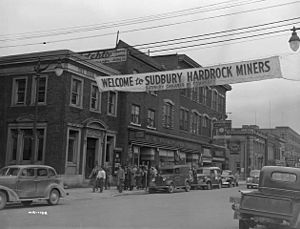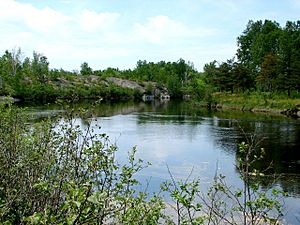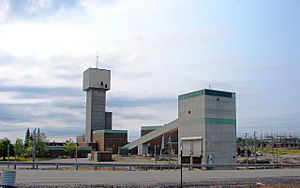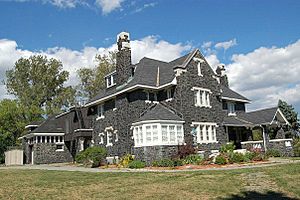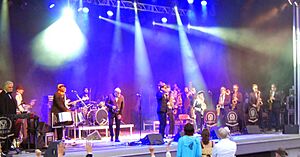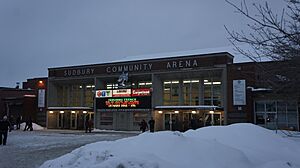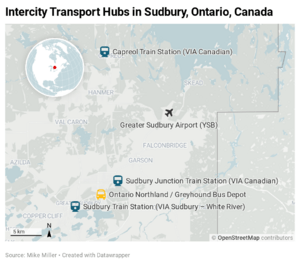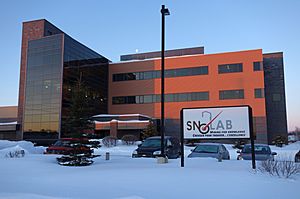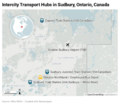Greater Sudbury facts for kids
Quick facts for kids
Greater Sudbury
|
|||||
|---|---|---|---|---|---|
| City of Greater Sudbury Ville du Grand Sudbury (French) |
|||||
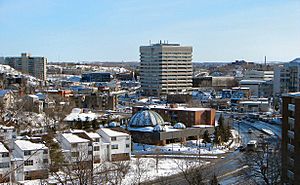
Downtown Sudbury
|
|||||
|
|||||
| Nicknames:
"Nickel Capital", "Nickel City", "The Big Nickel" "City of Lakes", "Sudz" (colloquially)
|
|||||
| Motto(s): | |||||
 |
|||||
| Country | Canada | ||||
| Province | Ontario | ||||
| Founded | 1883 | ||||
| Incorporated | 1893 (as town) | ||||
| Re-incorporated | 1930 (as city) 2001 (as Greater Sudbury) |
||||
| Area | |||||
| • Land | 3,186.26 km2 (1,230.22 sq mi) | ||||
| • Urban | 75.79 km2 (29.26 sq mi) | ||||
| • Metro | 4,187.40 km2 (1,616.76 sq mi) | ||||
| Elevation | 347.5 m (1,140.1 ft) | ||||
| Population
(2021)
|
|||||
| • Total | 166,004 (29th) | ||||
| • Density | 52.1/km2 (135/sq mi) | ||||
| • Urban | 92,093 | ||||
| • Urban density | 1,215.1/km2 (3,147/sq mi) | ||||
| • Metro | 170,605 (24th) | ||||
| • Metro density | 40.7/km2 (105/sq mi) | ||||
| Demonym(s) | Sudburian | ||||
| Time zone | UTC−05:00 (EST) | ||||
| • Summer (DST) | UTC−04:00 (EDT) | ||||
| Forward sortation area |
P3A to P3G, P3L, P3N, P3P, P3Y
|
||||
| Area code(s) | 705/249 | ||||
| Telephone exchanges | 705–207, 222, 280, 396, 397, 479, 507, 521, 522, 523, 524, 525, 546, 547, 550, 551, 552, 553, 554, 556, 560, 561, 562, 564, 566, 585, 596, 618, 626, 662, 664, 665, 669, 670, 671, 673, 674, 675, 677, 682, 688, 690, 691, 692, 693, 694, 695, 698, 699, 805, 822, 853, 855, 858, 866, 867, 897, 898, 899, 919, 920, 929, 966, 967, 969, 983 249-810, 878 | ||||
| Highways | |||||
| GDP (Greater Sudbury CMA) | CA$9.7 billion (2020) | ||||
| GDP per capita (Greater Sudbury CMA) | CA$54,491 (2016) | ||||
Greater Sudbury, often just called Sudbury, is the biggest city in Northern Ontario by how many people live there. In 2021, about 166,000 people called it home. It's also the largest city in Ontario by land area and the fifth largest in all of Canada. Greater Sudbury is a "single-tier municipality," which means it's a city that handles its own local government, not part of a larger county. It's surrounded by the Sudbury District, but it's a separate area. Many people who live here speak French, and they call the city "Ville du Grand Sudbury."
For thousands of years, the Ojibwe people lived in the Sudbury area. The city itself started in 1883 when workers building the Canadian Pacific Railway found lots of nickel and copper ore. In 2001, Greater Sudbury was formed by joining several smaller towns and cities into one big municipality. The city is located far from the coast, so it has very distinct seasons. Winters are cold and snowy, with average January lows around -18°C. Summers are warm, with average July highs around 25°C.
Most of the people in Greater Sudbury live in the main city area or in smaller communities. These communities are spread out among 330 lakes and hills. The hills often look dark because of past smelting (a process to get metal from ore) activities. Sudbury used to be a big lumber center and a world leader in nickel mining. Mining was the main industry for most of the 1900s. Companies like Inco (now Vale Limited) and Falconbridge (now Glencore) were very important. Today, Sudbury has grown beyond mining. It's now a major center for shopping, business, health care, education, and science in Northeastern Ontario. The city also has a large Franco-Ontarian (French-speaking Ontarian) population, which adds a lot to its arts and culture.
Contents
- Naming the City: Where Did the Name Sudbury Come From?
- Sudbury's Past: A Look at History
- Sudbury's Land: Exploring Geography
- People of Sudbury: Demographics
- Sudbury's Work: Economy and Jobs
- Sudbury's Spirit: Culture and Arts
- City Services: Infrastructure
- Learning in Sudbury: Education
- News and Entertainment: Media in Sudbury
- Famous Faces: Notable People from Sudbury
- Images for kids
- See also
Naming the City: Where Did the Name Sudbury Come From?
The name Sudbury was chosen by James Worthington. He was in charge of building the railway in Northern Ontario. He named the city after his wife's hometown, Sudbury, Suffolk, in England.
In 2001, the city's official name changed to Greater Sudbury. This happened when the main city joined with its nearby towns. The idea was to make sure the old town names and their unique identities weren't forgotten. But even today, most people still just call it Sudbury.
Sudbury's Past: A Look at History
The Sudbury area has been home to people for a very long time. The Ojibwe people, part of the Algonquin group, lived here as far back as 9,000 years ago. In 1850, local Ojibwe leaders made a deal with the British Crown. This deal, called the Robinson Huron Treaty, meant they would share a large area of land, including what is now Sudbury.
French Jesuits were the first Europeans to settle here. They set up a mission called Sainte-Anne-des-Pins in 1883, just before the railway was built. This church was very important for French-speaking culture in the area.
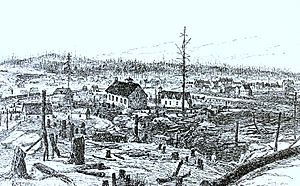
In 1883, during the railway construction, workers found a lot of nickel-copper ore at Murray Mine. This discovery brought the first European settlers. They came to work in the mines and to build a service station for the railway workers. Sudbury became a town in 1893.
The famous American inventor Thomas Edison visited Sudbury in 1901. He is known for finding the ore deposit at Falconbridge. Rich deposits of nickel sulphide ore were found in the Sudbury Basin. The railway made it easy to mine these minerals and ship them out. It also helped with large-scale lumber cutting.
Mining soon became more important than lumber. Sudbury's economy was mostly about mining for much of the 1900s. Two big mining companies, Inco (started in 1902) and Falconbridge (started in 1928), became major employers. They were also two of the world's top nickel producers.

Over the years, Sudbury's economy went up and down. This depended on how much nickel the world needed. Demand was very high during the First World War. Nickel from Sudbury was used a lot to make artillery (big guns) in England. When the war ended, demand dropped. But it rose again in the 1920s as people found new uses for nickel. Sudbury officially became a city in 1930.
The city recovered from the Great Depression faster than almost any other city in North America. This was because nickel demand increased in the 1930s. Sudbury was one of Canada's fastest-growing and wealthiest cities during this time. The city faced problems keeping up with new services needed for its fast growth. For example, even employed miners sometimes had to live in temporary homes because new housing couldn't be built fast enough. Another economic slowdown happened in 1937. But the city's luck improved again with wartime demands during the Second World War. The Frood Mine alone provided 40 percent of all the nickel used in Allied artillery during the war.
In the early to mid-1900s, the way mining companies processed ore and cut down trees for fuel caused a lot of damage to the local plants. The ground became exposed rock, stained black by air pollution. Acid rain also added more stains, going deep into the once pink-grey granite.
In 1972, the Inco Superstack was built. This tall chimney helped spread the sulphuric acid over a wider area, making local rain less acidic. This allowed the city, province, and mining companies to start a "regreening" program in the late 1970s. They spread lime and seeds by hand and from aircraft. By 2010, 9.2 million new trees had been planted. Vale has also started to fix up the slag heaps around their smelter by planting grass and trees.

In 1978, workers at Inco (now Vale) went on a long strike. This strike lasted nine months and hurt Sudbury's economy a lot. This made the city government decide to try and create more different types of jobs.
A special project called Science North opened in 1984. It has two snowflake-shaped buildings connected by a tunnel through the Canadian shield. The city worked to attract new businesses and industries in the 1980s and 1990s. In 2001, the city of Sudbury and its surrounding communities joined together to form the single city of Greater Sudbury.
In 2006, Inco was bought by a Brazilian company called CVRD (now Vale). Falconbridge was bought by a Swiss company called Xstrata, which later joined with Glencore to form Glencore Xstrata. The city's environment has improved a lot, thanks to regreening programs and better mining methods. In 1992, the United Nations honored Sudbury for its community efforts to clean up the environment. By 2010, about 3,350 hectares of land had been fixed up.
Sudbury's Land: Exploring Geography
Greater Sudbury is famous for its many lakes. There are 330 lakes larger than 10 hectares within the city limits! Lake Wanapitei is the biggest lake in the world that is completely inside one city. Ramsey Lake, closer to downtown, used to hold this record before the city grew in 2001. Sudbury has two main river systems: the French River to the east, which flows into Georgian Bay, and the Spanish River to the west, which flows into Lake Huron.
Sudbury is built among many small, rocky mountains. These are made of exposed igneous rock from the Canadian (Precambrian) Shield. The valuable minerals in Sudbury are found in a huge geological area called the Sudbury Basin. This basin is almost two billion years old! Scientists believe it was formed by a giant meteorite or possibly a comet hitting the Earth.
The ores found in Sudbury contain profitable amounts of many elements. These include nickel and copper, as well as platinum, palladium, and other valuable metals.
In the past, the process of getting metal from ore (smelting) released a lot of sulphur into the air. This sulphur mixed with water to form sulphuric acid, which caused acid rain. Because of this, Sudbury was once known as a damaged wasteland. In some parts of the city, plants were destroyed by acid rain and by logging (cutting trees for fuel). The ground became exposed rock, often charred black.

During the Apollo space missions, NASA astronauts trained in Sudbury. They learned about special rock formations caused by large meteorite impacts. There's a common misunderstanding that they trained here because the area looked like the Moon.
The city's Nickel District Conservation Authority runs the Lake Laurentian Conservation Area. This is a protected natural area in the city's south end. Other special environmental projects include the Fielding Bird Sanctuary and a nature trail named after scientist Jane Goodall.
Six provincial parks and two provincial conservation reserves are also partly or fully within the city's boundaries.
Sudbury's Weather: Climate Overview
Greater Sudbury has a humid continental climate. This means it has warm, often humid summers, sometimes with short periods of hot weather. Winters are long, cold, and snowy. The city is north of the Great Lakes, so it often gets cold air from the Arctic. It rains or snows about the same amount all year. Snow usually covers the ground for up to six months. Extreme weather is rare, but a very bad tornado hit the city in 1970. It killed six people and caused a lot of damage.
The hottest temperature ever recorded in Greater Sudbury was 41.1°C on July 13, 1936. The coldest was -48.3°C on December 29, 1933.
| Climate data for Sudbury Airport, 1991−2020 normals, extremes 1887−present | |||||||||||||
|---|---|---|---|---|---|---|---|---|---|---|---|---|---|
| Month | Jan | Feb | Mar | Apr | May | Jun | Jul | Aug | Sep | Oct | Nov | Dec | Year |
| Record high humidex | 7.2 | 10.0 | 27.9 | 30.7 | 39.4 | 41.4 | 43.5 | 49.2 | 38.7 | 34.3 | 21.7 | 17.7 | 49.2 |
| Record high °C (°F) | 10.0 (50.0) |
9.4 (48.9) |
25.9 (78.6) |
29.8 (85.6) |
35.6 (96.1) |
35.7 (96.3) |
41.1 (106.0) |
36.7 (98.1) |
34.4 (93.9) |
27.8 (82.0) |
20.1 (68.2) |
15.6 (60.1) |
41.1 (106.0) |
| Mean daily maximum °C (°F) | −7.8 (18.0) |
−5.9 (21.4) |
0.5 (32.9) |
8.6 (47.5) |
17.4 (63.3) |
22.6 (72.7) |
25.0 (77.0) |
23.5 (74.3) |
18.6 (65.5) |
10.6 (51.1) |
2.9 (37.2) |
−3.9 (25.0) |
9.3 (48.7) |
| Daily mean °C (°F) | −12.7 (9.1) |
−11.1 (12.0) |
−4.9 (23.2) |
3.3 (37.9) |
11.4 (52.5) |
16.8 (62.2) |
19.1 (66.4) |
18.0 (64.4) |
13.3 (55.9) |
6.2 (43.2) |
−0.8 (30.6) |
−7.8 (18.0) |
4.3 (39.7) |
| Mean daily minimum °C (°F) | −17.5 (0.5) |
−16.3 (2.7) |
−10.2 (13.6) |
−2.0 (28.4) |
5.3 (41.5) |
11.0 (51.8) |
13.4 (56.1) |
12.5 (54.5) |
8.1 (46.6) |
1.9 (35.4) |
−4.4 (24.1) |
−11.7 (10.9) |
−0.8 (30.6) |
| Record low °C (°F) | −42.8 (−45.0) |
−42.8 (−45.0) |
−41.1 (−42.0) |
−27.8 (−18.0) |
−12.8 (9.0) |
−1.6 (29.1) |
−0.6 (30.9) |
−1.1 (30.0) |
−5.7 (21.7) |
−13.9 (7.0) |
−31.7 (−25.1) |
−48.3 (−54.9) |
−48.3 (−54.9) |
| Record low wind chill | −53.1 | −50 | −43.2 | −32.4 | −15.2 | −8.6 | 0.0 | −5.0 | −9.2 | −16.6 | −36.3 | −51 | −53.1 |
| Average precipitation mm (inches) | 66.8 (2.63) |
51.1 (2.01) |
58.3 (2.30) |
67.8 (2.67) |
79.2 (3.12) |
77.4 (3.05) |
84.0 (3.31) |
89.9 (3.54) |
103.2 (4.06) |
93.8 (3.69) |
74.5 (2.93) |
65.9 (2.59) |
911.9 (35.90) |
| Average rainfall mm (inches) | 14.2 (0.56) |
7.6 (0.30) |
27.5 (1.08) |
52.3 (2.06) |
76.9 (3.03) |
77.0 (3.03) |
84.0 (3.31) |
89.9 (3.54) |
103.1 (4.06) |
87.1 (3.43) |
49.0 (1.93) |
16.4 (0.65) |
685.0 (26.97) |
| Average snowfall cm (inches) | 63.6 (25.0) |
51.9 (20.4) |
33.1 (13.0) |
16.1 (6.3) |
2.3 (0.9) |
0.0 (0.0) |
0.0 (0.0) |
0.0 (0.0) |
0.1 (0.0) |
6.5 (2.6) |
30.2 (11.9) |
59.6 (23.5) |
263.4 (103.7) |
| Average precipitation days (≥ 0.2 mm) | 18.3 | 14.2 | 11.4 | 11.0 | 12.4 | 12.4 | 12.8 | 12.5 | 13.4 | 15.5 | 16.0 | 18.1 | 168.0 |
| Average rainy days (≥ 0.2 mm) | 3.0 | 2.0 | 4.4 | 8.3 | 12.0 | 12.5 | 12.8 | 12.5 | 13.4 | 14.4 | 8.7 | 4.6 | 108.7 |
| Average snowy days (≥ 0.2 cm) | 17.6 | 14.2 | 9.3 | 4.8 | 0.81 | 0.04 | 0.0 | 0.0 | 0.13 | 3.0 | 10.2 | 15.8 | 75.9 |
| Average relative humidity (%) (at 15:00) | 71.8 | 64.4 | 55.6 | 49.9 | 47.7 | 51.4 | 53.4 | 55.9 | 60.3 | 65.5 | 73.3 | 76.1 | 60.5 |
| Mean monthly sunshine hours | 86.3 | 118.2 | 161.0 | 195.6 | 228.4 | 246.9 | 274.7 | 245.2 | 162.1 | 121.4 | 69.8 | 63.5 | 1,973.2 |
| Percent possible sunshine | 30.9 | 40.7 | 43.7 | 48.1 | 49.1 | 52.2 | 57.4 | 55.8 | 42.9 | 35.8 | 24.6 | 23.7 | 42.1 |
| Source: Environment Canada (sun 1981–2010) | |||||||||||||
Local Areas: Communities within Greater Sudbury
In 2001, the city of Sudbury and its nearby towns joined to form the single city of Greater Sudbury. Even though they are now one city, people still often use the old names for the smaller communities. These communities keep some of their own unique identities.
The former municipalities that joined in 2001 included: Sudbury (with 85,354 people in 2001) and Valley East (22,374 people). The towns were Rayside-Balfour (15,046), Nickel Centre (12,672), Walden (10,101), Onaping Falls (4,887), and Capreol (3,486). The Wanup area and a large wilderness area near Lake Wanapitei were also added to the city.
People of Sudbury: Demographics
In 2021, Greater Sudbury had a population of 166,004 people. This was a small increase from 2016. The city's land area is about 3,186 square kilometers. This means there are about 52 people living in each square kilometer.
The average age in Greater Sudbury in 2021 was 43.2 years. This is a bit older than the average age for all of Ontario, which was 41.6 years.
| Historical census populations – Sudbury | |||||||||||||||||||||||||||||||||||||||||||
|---|---|---|---|---|---|---|---|---|---|---|---|---|---|---|---|---|---|---|---|---|---|---|---|---|---|---|---|---|---|---|---|---|---|---|---|---|---|---|---|---|---|---|---|
|
|
||||||||||||||||||||||||||||||||||||||||||
| Source: Statistics Canada | |||||||||||||||||||||||||||||||||||||||||||
| Historical census populations – Greater Sudbury | ||||||||||||||||||||||
|---|---|---|---|---|---|---|---|---|---|---|---|---|---|---|---|---|---|---|---|---|---|---|
|
|
|||||||||||||||||||||
| Source: Statistics Canada | ||||||||||||||||||||||
Who Lives Here: Ethnicity and Backgrounds
Greater Sudbury has a smaller number of visible minorities compared to the rest of Canada. However, it has a much higher percentage of Indigenous Canadians. In 2021, about 2.5% of the population was Black, 1.9% South Asian, and 0.6% Chinese.
|
||||||||||||||||||||||||||||||||||||||||||||
| Panethnic group |
2021 | 2016 | 2011 | 2006 | 2001 | |||||
|---|---|---|---|---|---|---|---|---|---|---|
| Pop. | % | Pop. | % | Pop. | % | Pop. | % | Pop. | % | |
| European | 134,275 | 82.36% | 137,715 | 86.8% | 140,605 | 89.12% | 143,125 | 91.75% | 143,365 | 93.39% |
| Indigenous | 17,930 | 11% | 14,960 | 9.43% | 12,960 | 8.21% | 9,590 | 6.15% | 7,020 | 4.57% |
| African | 4,030 | 2.47% | 1,455 | 0.92% | 935 | 0.59% | 1,095 | 0.7% | 1,075 | 0.7% |
| South Asian | 3,105 | 1.9% | 1,465 | 0.92% | 630 | 0.4% | 575 | 0.37% | 535 | 0.35% |
| East Asian | 1,230 | 0.75% | 1,165 | 0.73% | 995 | 0.63% | 755 | 0.48% | 830 | 0.54% |
| Southeast Asian | 840 | 0.52% | 680 | 0.43% | 520 | 0.33% | 295 | 0.19% | 190 | 0.12% |
| Latin American | 705 | 0.43% | 275 | 0.17% | 290 | 0.18% | 180 | 0.12% | 220 | 0.14% |
| Middle Eastern | 485 | 0.3% | 725 | 0.46% | 545 | 0.35% | 170 | 0.11% | 180 | 0.12% |
| Other | 435 | 0.27% | 235 | 0.15% | 290 | 0.18% | 200 | 0.13% | 110 | 0.07% |
| Total responses | 163,030 | 98.21% | 158,665 | 98.23% | 157,765 | 98.43% | 155,995 | 98.82% | 153,510 | 98.9% |
| Total population | 166,004 | 100% | 161,531 | 100% | 160,274 | 100% | 157,857 | 100% | 155,219 | 100% |
- Note: Totals greater than 100% due to multiple origin responses.
Beliefs and Faiths: Religion in Sudbury
| Religions in Sudbury | ||||
|---|---|---|---|---|
| Religion | Percent | |||
| Catholic Christian | 46.8% | |||
| No Religion/Secular | 33.2% | |||
| Protestant Christians | 10.4% | |||
| Christian (not otherwise specified) | 3.9% | |||
| Others | 3.2% | |||
| Other Christian/Christian Related Tradition | 2.6% | |||
| Census Profile 2021 | ||||
Most people in Greater Sudbury are Christian. About 64% of the population belongs to Christian groups. Catholics make up the largest single group, at 47%. About 33% of people said they had no religious affiliation. Other religions like Islam, Judaism, and Hinduism make up about 3% of the population.
Speaking in Sudbury: Language Use
Sudbury is a bilingual city, meaning two languages are commonly spoken. A large part of the population speaks French. About 37.5% of Sudburians can speak French, and for 22.6%, French is their first language. Most people (83.8%) speak English at home. French is spoken at home by 10.6% of the population.
Sudbury's Work: Economy and Jobs
After being a lumber camp for a short time, Sudbury's economy was mainly about mining for most of the 1900s. By the 1970s, the company Inco employed a quarter of all workers in the area. Today, mining companies like Vale (from Brazil) and Glencore Xstrata (from Switzerland) operate here. Other mining companies also have operations in the Sudbury area.
Now, mining directly employs about 6,000 people. But another 10,000 people work in companies that supply goods and services to the mining industry. By 2006, 80% of Greater Sudbury's workers were in service jobs, while 20% were in manufacturing. Over 345 companies that support mining are located in Sudbury. These include groups that do research and development for new mining technologies.
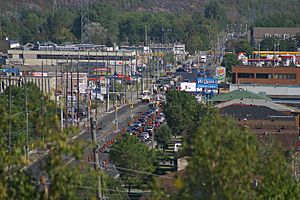
Even though mining is less dominant now, Sudbury's economy has grown to include many different areas. It's a major center for money, business, tourism, health care, education, government, and science research. This is because Sudbury serves as a regional hub for Northeastern Ontario, a market of 550,000 people.
Here are some of the biggest employers in Sudbury as of November 2010:
| Company / organization | Employees | Sector |
|---|---|---|
| Vale | 3,999 | Mining |
| Health Sciences North | 3,700 | Health services |
| Sudbury Tax Services Office | 2,800 | Federal government |
| City of Greater Sudbury | 2,166 | Municipal government |
| Laurentian University | 1,850 | Education |
| Rainbow District School Board | 1,606 | Education |
| Ontario Ministries and Agencies | 1,500 | Ontario government |
| Conseil scolaire catholique du Nouvel-Ontario | 1,443 | Education |
| Xstrata | 1,139 | Mining |
Many shops and businesses have moved out of the downtown area. The city has been working to make the downtown lively again. Projects include creating a farmer's market, improving the Rainbow Center Mall, and making streets look nicer. They also turned old buildings into offices and homes. The McEwen School of Architecture and cultural events like the Up Here art and music festival have also helped. New projects include the Place des Arts, a center for performing and visual arts.
However, a lot of the city's shopping is still outside downtown. You can find big shopping areas at the Four Corners, the RioCan and Silver Hills power centres, and the New Sudbury Centre. The New Sudbury Centre is the biggest shopping mall in Northern Ontario with 110 stores.
Lights, Camera, Action: Film Industry in Sudbury
Sudbury has a growing film and television industry. Many projects have been filmed here since the 2000s. The Cinéfest Sudbury International Film Festival helped start this industry in the early 1990s. Now, Music and Film in Motion, a local group, helps manage it.
Movies filmed in Sudbury include Resident Evil: Welcome to Raccoon City and Men with Brooms. TV shows like Letterkenny and Shoresy have also been filmed here.
March Entertainment's studio in Sudbury has made animated TV shows like Chilly Beach.
Building Blocks: Architecture in Sudbury
With the new Laurentian University McEwen School of Architecture and more building in the city, architecture is becoming more important to Sudbury's economy.
Some notable buildings in Greater Sudbury are:
- Ledo Hotel: A historic building downtown, built in 1910.
- St. Andrew's Place: A church and community complex opened in 1972.
- Sudbury's Shaar Hashomayim Synagogue: Built in 1960, it's the only synagogue in Sudbury.
- Moses Block: Sudbury's only flatiron building, built in 1907.
Sudbury's Spirit: Culture and Arts
More than 22% of people in Greater Sudbury speak French as their first language. This large Franco-Ontarian community greatly influences the city's culture. This is especially true in areas like Valley East and Rayside-Balfour. The Franco-Ontarian flag, which was created in 1975, celebrates French culture. It flies at Tom Davies Square, the city hall. The French-speaking community helps run many cultural places in Sudbury. These include the Théâtre du Nouvel-Ontario (a theatre), La Nuit sur l'étang (a music festival), and La Galerie du Nouvel-Ontario (an art gallery). The city hosted a big French-speaking youth event, Les Jeux de la francophonie canadienne, in 2011.
Creative Expressions: Arts in Sudbury
The Sudbury Arts Council started in 1974. Its job is to connect, share, and celebrate the arts. The city has two art galleries: the Art Gallery of Sudbury and La Galerie du Nouvel-Ontario. Both focus on Canadian art, especially from Northern Ontario.
The city's only professional French theatre company is the Théâtre du Nouvel-Ontario (TNO). It is one of seven groups located at the Place des Arts. The Sudbury Theatre Centre, which used to be the only professional English theatre, joined with YES Theatre in 2023. Many community groups and high schools also put on plays.
In 2021, YES Theatre announced plans for the Refettorio. This will be an outdoor space for theatre and music performances. It opened in August 2023 with a play by Shakespeare.
The Place des Arts is a new building that opened in 2022. It's a community hub for French cultural groups. It has a concert hall, a theatre studio, an art gallery, and space for artists.
Celebrations: Festivals in Sudbury
The Cinéfest Sudbury International Film Festival is the city's main film festival. It happens every September. There are also smaller film festivals for documentaries and LGBT-themed films. Mainstream movies are shown at the SilverCity theatre. Science North has an IMAX theatre. The Sudbury Indie Cinema Co-op shows independent and international films.
In 2021, the Sudbury Indie Cinema Co-op also started the Sudbury Outdoor Adventure Reels Film Festival. In 2022, they launched two more: the Sudbury's Tiny Underground Film Festival (STUFF) for experimental films, and the Sudbury Indie Creature Kon for horror films.
The city has hosted an annual Sudbury Pride festival since 1997.
The Up Here Festival, started in 2015, combines music performances with creating murals and installation art downtown. PlaySmelter, a theatre festival for local writers and actors, started in 2013.
In music, the city hosts the Northern Lights Festival Boréal and La Nuit sur l'étang festivals.
Sudbury also has Northern Ontario's only Japanese cultural Festival, Japan Festival Sudbury. It started in 2019 and returned in 2022.
Stories and Books: Literature in Sudbury
Many books are set in or around Sudbury. These include Robert J. Sawyer's The Neanderthal Parallax series and Alistair MacLeod's novel No Great Mischief. The city is also called "Chinookville" in some books by Jack Douglas.
Many well-known writers have lived in Sudbury. These include playwrights, poets, and fiction writers. In 2010, the city created the job of Poet Laureate. Roger Nash was the first person to hold this role.
Sounds of Sudbury: Music Scene
Sudbury's most successful musicians have often been in country, folk, and country-rock styles. These include Robert Paquette and Kate Maki.
Big concerts happen at the Sudbury Community Arena. Other touring acts play at places like the Grand Theatre.
Bell Park's outdoor Grace Hartman Amphitheatre is the main place for the Northern Lights Festival Boréal. It also hosts other summer concerts.
Besides the Northern Lights Festival Boréal, the city also has the Up Here Festival. This festival mixes music with public art projects. La Nuit sur l'étang is a festival of French-language music.
The local Sudbury Symphony Orchestra plays classical music concerts regularly. They usually perform at the Sheridan Auditorium at Sudbury Secondary School.
Sudbury is also home to the Blue Saints Drum and Bugle Corps, a youth music group active since 1952.
One of Stompin' Tom Connors' most famous songs, "Sudbury Saturday Night", describes the fun social life of hard rock miners in Sudbury.
Fun Things to Do: Attractions in Sudbury

Science North is an interactive science museum and the most popular tourist spot in Northern Ontario. It gets about 288,000 visitors each year. It has two snowflake-shaped buildings on the shore of Ramsey Lake. There's also an old ice hockey arena with the entrance and an IMAX theatre. The buildings are connected by a tunnel through a billion-year-old geologic fault.
Sudbury's mining history is shown at another big attraction, Dynamic Earth. This museum focuses on geology and mining. It's also home to the Big Nickel, one of Sudbury's most famous landmarks. The city also has the Greater Sudbury Heritage Museums, which are local history museums. There's also a mining monument at Bell Park.
The Inco Superstack was once the tallest freestanding chimney in the world. It's 380 meters tall, almost as high as the roof of the Empire State Building. It is now the second tallest structure in Canada after the CN Tower.
Staying Active: Sports in Sudbury
Sudbury has many trails for year-round use. The Sudbury Trail Plan prepares almost 1,200 kilometers of trails for snowmobiles in winter. There are also about 200 kilometers of trails for hiking, biking, and jogging. The Lake Laurentian Conservation Area has 23 kilometers of trails. Other trails connect Sudbury to outside areas, like the Trans Canada Trail. The city also has Sudbury Downs, a harness racing track in Azilda.
The city is home to several sports teams. The Sudbury Wolves are an ice hockey team in the Ontario Hockey League. They play at the Sudbury Community Arena. The Sudbury Spartans football club has played in the Northern Football Conference since 1954. Laurentian University and Cambrian College also have sports teams that compete in college leagues. High school students compete in the Sudbury District Secondary School Athletic Association (SDSSAA).
Greater Sudbury also has a professional basketball team, the Sudbury Five. They play at the Sudbury Community Arena and started in the National Basketball League of Canada in 2018.
City Services: Infrastructure
Helping Hands: Emergency Services
Greater Sudbury has its own police force, the Greater Sudbury Police Service. There's also a branch of the Ontario Provincial Police here. Greater Sudbury Emergency Medical Services provides paramedic services with over 150 paramedics. Greater Sudbury Fire Services has 24 fire stations across the city. They have both full-time staff and volunteer firefighters.
Powering the City: Utilities
Greater Sudbury Utilities Inc. (GSU) provides utility services in the city's main areas. The City of Greater Sudbury owns this company.
Getting Around: Transportation
City Buses: Public Transportation
The city has a bus system called GOVA. It transported 4.4 million passengers in 2012. In 2000, when the nearby towns joined Sudbury, the bus service area became much larger. The Downtown Transit Center is the main hub for buses in Sudbury.
Flying High: Air Travel
The Greater Sudbury Airport has two paved runways. It serves over 270,000 passengers each year. Three regional airlines fly from here: Air Canada Express to Toronto Pearson International Airport, Porter Airlines to Billy Bishop Toronto City Airport, and Bearskin Airlines to several places in Northern Ontario.
Traveling Between Cities: Intercity Transportation
Several companies offer ways to travel to and from Sudbury. Via Rail's Sudbury–White River train serves remote communities, some only reachable by train. The Capreol station and Sudbury Junction station are stops for Via Rail's cross-Canada passenger service, the Canadian. This train passes through the area twice a week.
You can also take intercity buses from the Sudbury Ontario Northland Bus Terminal. Ontario Northland buses go to places like North Bay, Sault Ste. Marie, Toronto, and Ottawa.
On the Road: Highways and Roads
Three highways connect Sudbury to the rest of Ontario. Highway 17 is part of the Trans-Canada Highway. It connects the city to places east and west. A part of Highway 17 is a freeway. This highway goes around the city's main area, helping traffic pass through. The old route of Highway 17 through the city is now called Municipal Road 55.
Highway 69 also connects to the Trans-Canada Highway. It goes south to Parry Sound, where it links to Highway 400 to Toronto. Highway 400 is being extended to Greater Sudbury. Highway 144 goes north to Highway 101 in Timmins.
Greater Sudbury is the only area in Northern Ontario that has its own system of numbered municipal roads. This is similar to the county road system in southern Ontario.
Learning in Sudbury: Education
Greater Sudbury has three colleges and universities. Laurentian University is a bilingual university with about 9,000 students. Cambrian College is an English college with 4,500 full-time students. Collège Boréal is a French college with 2,000 students. The Northern Ontario School of Medicine is also here. In 2013, Laurentian University opened the McEwen School of Architecture downtown. It was the first new architecture school in Canada in over 40 years.
The Vale Living with Lakes Centre opened in 2011 at Laurentian University. It studies how things affect the health of water ecosystems. This helps improve Sudbury's environment. Sudbury is also home to SNOLAB, the second-deepest underground laboratory in the world. Scientists there do experiments on dark matter.
English public schools are run by the Rainbow District School Board. They have 28 elementary schools and nine secondary schools. The Sudbury Catholic District School Board offers publicly funded English Catholic education. They have 16 elementary schools and five high schools. French public schools are managed by the Conseil scolaire de district du Grand Nord de l'Ontario. They have seven elementary and two secondary schools. The Conseil scolaire catholique du Nouvel-Ontario provides publicly funded French Catholic education. They have 15 elementary and four secondary schools. There are also two Christian private schools and two Montessori schools.
The Greater Sudbury Public Library system has 13 branches. In 2011, the library had 600,000 items. Over 50% of the people living in Sudbury use the library.
News and Entertainment: Media in Sudbury
As the biggest city in Northern Ontario, Greater Sudbury is the main media center for the region. Many smaller cities in Northeastern Ontario get their news and entertainment from Sudbury-based media. For example, CICI-TV produces most local shows for the CTV Northern Ontario system. Also, CBC Radio stations CBCS-FM and CBON-FM broadcast to the entire region.
Sudbury's daily newspaper is the Sudbury Star. It's published six days a week. The city's long-time community newspaper Northern Life stopped printing in 2020. It now operates online as Sudbury.com.
There is also a weekly French newspaper called Le Voyageur.
Famous Faces: Notable People from Sudbury
Many famous people are from Sudbury. These include Alex Trebek, who hosted the TV game show Jeopardy!. Michelle O'Bonsawin is a Justice on the Supreme Court of Canada. Jason F. McLennan is an architect who created the Living Building Challenge. Paul Desmarais Jr. is the chairman of Power Corporation of Canada. Frank Giustra is a mining investor and helper of charities. Leo Gerard was president of United Steelworkers.
In sports, Cloé Lacasse plays for the Canada national soccer team. Randy Carlyle was a head coach for the Anaheim Ducks and Toronto Maple Leafs hockey teams. Olympic swimmer Alex Baumann is from Sudbury. Rebecca Johnston plays for the Canadian Women's Hockey Team. Tessa Bonhomme was also a player. Sudbury has produced 81 National Hockey League hockey players. These include Hockey Hall of Fame members like Eddie Giacomin and George Armstrong.
Images for kids
-
A Canadian Pacific Railway junction in Sudbury in 1888. Building the railway led to finding lots of nickel-copper ore near the Sudbury Basin.
-
Smelting works of the Canadian Copper Company before World War I. Most of the nickel from Sudbury was used to make weapons during the war.
-
The Inco Superstack in 1976, four years after it was finished. It was built to spread sulphuric acid and make local rain less acidic.
-
The Wanapitei River in Sudbury. It's part of the Great Lakes Basin and flows into the French River.
-
Erosion has left bedrock exposed in many parts of the city. Much of it is charred black.
-
Barry Downe Road in Sudbury, with many businesses in the service sector visible. By 2006, 80 percent of Greater Sudbury's workers were in service jobs.
-
The Art Gallery of Sudbury was started in 1967. It's one of two art galleries in the city.
-
In the early 2000s, the Big Nickel was moved to Science North while its original spot was being turned into Dynamic Earth.
See also
 In Spanish: Gran Sudbury para niños
In Spanish: Gran Sudbury para niños





